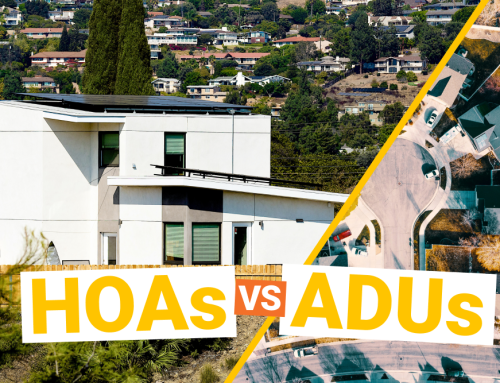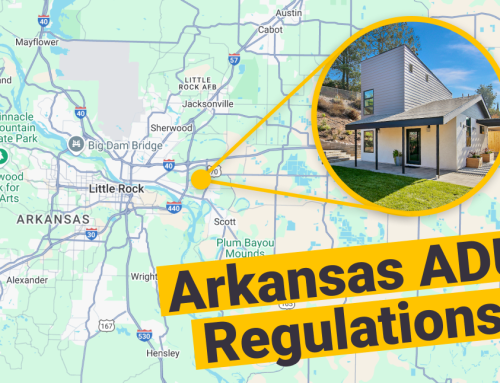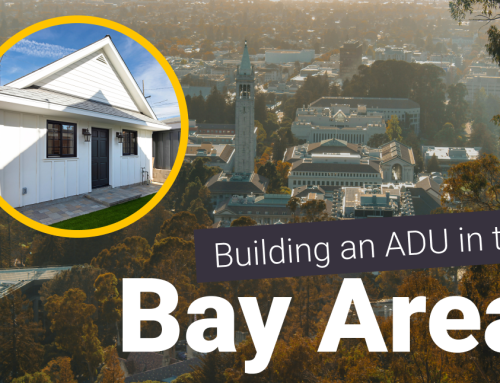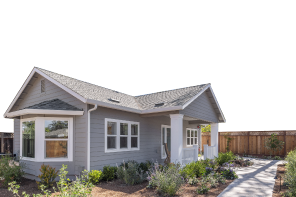Although SB9 doesn’t directly address accessory dwelling units (ADUs), the two go hand in hand and are often talked about within the same hemisphere. Both deal with increasing housing density in California through groundbreaking policy changes.
But, as SB9 is a relatively newer concept, it’s raised a lot of questions about how it works, what’s allowed, and how it intersects with existing zoning regulations and land use policies. Let’s break down some of those questions.
SB9 Explained
First, let’s breakdown what SB9 actually entails.
SB9 consists of two big parts: (1) the duplex provision and (2) the lot-split provision. The duplex provision allows for a single-family lot to now have two full-sized living units. Alternatively, the lot-split provision is what it sounds like. It allows for a residential lot to be divided and sold separately.
The two provisions can also be used together. A property owner can split their lot and add two units to each, now creating four units on a property that originally could only contain one. Great deal!
As with any new policy, there are some things to clarify.

FAQ #1: Can I do an SB9 second unit AND an ADU on my property (no lot split)?
Yes! Under SB9, homeowners in California can indeed take advantage of the duplex provision to convert a single-family property into a duplex property, and add an accessory dwelling unit (ADU) on the same lot. If you’ve kept up to date with the regulations around multi-family properties and ADUs, you’ll remember that there are some added benefits to this.
For multi-family properties, every jurisdiction is California must allow you to build converted ADUs from existing spaces AND up to eight detached ADUs, depending on how many existing living units are already on the property.
So, if you use SB9 to create a duplex, your property is now considered multi-family. That means you unlock those additional ADU allowances. In practice, most homeowners won’t build anywhere near the maximum number of ADUs allowed, but the key takeaway is this: SB9 and ADU laws can work together to give you more flexibility and housing options on a single property.
Always check with your local planning department, since each jurisdiction can apply its own development standards (like setbacks, height limits, and parking) that will shape what’s actually feasible on your lot.
FAQ #2: Can I add ADUs if I do a lot-split and the duplex provision of SB9?
No, you cannot do both provisions of SB9 (duplex and lot-split) and add ADUs. While it would be nice to have eight units on a property, policymakers have to draw the line somewhere. SB9 is structured to balance increased housing density with considerations for neighborhood layout, infrastructure capacity, and local zoning regulations. As such, homeowners and developers must adhere to the specific provisions outlined in SB9 and any additional requirements set forth by their local jurisdiction.

FAQ #3: How long does it take to split a lot?
Although you’re not physically cutting the land in half, the paperwork side of a lot split can be surprisingly lengthy. In most California cities, the process takes anywhere from 18 months to two years.
Why so long? A few reasons:
-
City review process – Your application has to move through multiple departments (planning, zoning, engineering, and sometimes utilities). Each step can add weeks or months.
-
Newness of SB9 – Because SB9 is still relatively new, many planning departments are refining their internal processes, which often leads to delays while staff clarify requirements.
-
Local standards – Cities can apply their own development standards for setbacks, easements, or access requirements, which sometimes means going back and forth with revised plans.
-
Coordination with surveyors and title companies – You’ll likely need a professional land survey, and once approved, the new legal lots must be recorded with the county before you can move forward.
Bottom line: even though SB9 was designed to make lot splits easier, it’s still a bureaucratic process that takes patience and persistence.
FAQ #4: What lots are ideal for lot-splits?
For starters, there are basic requirements that need to be met for a lot split. The lot needs to be at least 1,200 sq ft and the split cannot be greater than 60/40. This means that the two lots need to be similar in size.
Next, you need to consider the logistics of the split. Properties that are in the middle of a street may face some extra difficulties as you need to consider how people will access the lot. Flag lots are an option, but some jurisdictions may give you some pushback.
An ideal property to be split would be either a corner lot or a property with alley access. Ultimately, thorough evaluation of the property’s characteristics and adherence to regulatory requirements are essential steps in the lot-split process. By carefully navigating these considerations, homeowners and developers can maximize the potential of their properties while ensuring compliance with SB9 provisions and local regulations.

FAQ #5: How much does an SB9 lot-split cost?
The cost for an SB9 lost split starts at about $55,000.
The cost of an SB9 lot-split can vary significantly depending on various factors such as the location of the property, its size, the complexity of the split, and any additional requirements or fees imposed by local planning departments. You can expect to pay anywhere from $10,000 to $100,000, which is quite a big range. However, here are some common expenses associated with the lot-split process:
- Application Fees: Most jurisdictions require an application fee to review and process the lot-split application. The fee amount can vary widely depending on the locality but typically ranges from several hundred to several thousand dollars.
- Survey and Engineering Costs: Before initiating the lot-split process, you’ll likely need to hire a licensed surveyor or engineer to prepare the necessary documentation, including boundary surveys, parcel maps, and site plans. The cost of these services can vary based on the size and complexity of the property. However, they may range from a few thousand to tens of thousands of dollars.
- Legal and Administrative Fees: You may need to engage the services of legal professionals or administrative consultants to navigate the legal and regulatory aspects of the lot-split process. These fees can vary depending on the complexity of the project and the extent of legal assistance required.
It’s essential to budget carefully and consult with professionals familiar with the lot-split process in your area to obtain accurate cost estimates. Maxable can help you out with matching you with experienced professionals! Schedule an call with our team today.

FAQ #6: What are the limitations of SB9?
With SB9, there are two big requirements that are often overlooked:
Owner Occupancy: You are required to live on one of the properties for at least three years and sign an affidavit. This is to prevent investors from purchasing large amounts of lots just to split them and sell.
Preserving Existing Units: For both the lot-split and duplex provision, you cannot demolish any of the existing units that have been rented within the last three years. This is to ensure that existing housing remains intact.
These requirements are in place to protect affordable housing and ensure the equitable distribution of housing opportunities within California communities.
FAQ #7: How many times can I split my lot under SB9?
Under SB 9, you’re only allowed to split your lot once.
This means that the original parcel can be divided into no more than two lots. You can’t keep splitting the newly created lots again using SB 9. The law was designed to gently increase housing density without overburdening infrastructure, so its provisions are intentionally limited. If you already took advantage of a previous lot split (under SB 9 or otherwise), your property likely won’t qualify again. Always confirm eligibility with your local planning department before moving forward.
Get Your ADU & SB9 Needs From Maxable
Whether you’re building a simple 500 sq ft ADU or taking advantage of SB9 to split your lot, having a great designer and general contractor by your side is going to make a world of a difference. At Maxable, we’ve built a network of professionals all over California to assist homeowners in getting their projects off the ground. Schedule a call with our team today and meet your personalized ADU expert match.







